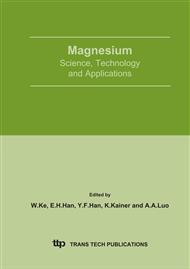p.575
p.581
p.585
p.589
p.593
p.597
p.601
p.605
p.611
Effect of Microstructures and Texture Development on Tensile Properties of Wrought Magnesium Alloys Processed by ECAE
Abstract:
4-pass ECAE processing was applied to two kinds of magnesium alloys, AZ31 and ZK31. Subsequently, hot rolling was carried out as a secondary forming process. After ECAE processing, the samples have fine and equiaxed grains. The basal plane of AZ31 alloy is inclined at about 450 to the extrusion direction, while that of ZK31 alloy is parallel to the extrusion direction. As a result, tensile strength and 0.2% proof stress of ZK31 alloy are higher than those of AZ31 alloy. On the other hand, the basal plane orients parallel to the rolled surface in the Subsequently rolled samples and, therefore, tensile strength and 0.2% proof stress are improved significantly. Furthermore, the AZ31 alloy has higher ductility than ZK31 alloy.
Info:
Periodical:
Pages:
593-596
Citation:
Online since:
July 2005
Authors:
Keywords:
Price:
Сopyright:
© 2005 Trans Tech Publications Ltd. All Rights Reserved
Share:
Citation:


